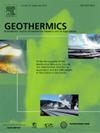印度多种地热勘探方法综述及未来发展方向
IF 3.9
2区 工程技术
Q3 ENERGY & FUELS
引用次数: 0
摘要
印度对-à-vis的电力需求激增,解决气候问题的可持续发展努力已经影响了政策向可再生能源的转变。在这些能源中,地热能成为一种很有前途的绿色替代能源。该国的地热潜力由381个间歇泉和温泉的存在证明,地表至近地表温度从97°C到150°C不等。虽然是基础性的,但研究主要集中在地球化学表征和区域尺度的热成像上,而印度的地热开发仍处于早期阶段。虽然复杂的地质是许多地热地区的共同特征,但印度地热省不同的构造环境给地下表征带来了额外的挑战。为了控制这些丘陵复杂地形的高成本勘探,需要将地面和地下地球物理方法相结合。本文对印度以前的研究进行了最新的、广泛的回顾,包括促进地热勘探及其商业化的政策发展的最新进展。进行了文献计量分析,以了解科学文章对印度地热勘探和开发的贡献。考虑到最新的数据,作者提出了一个新的印度地热省图和印度半岛的热流图来支持他们的论点。本文为研究人员、政策制定者和行业提供了印度地热勘探的导航仪。本文强调了遥感、地球物理、地质和地球化学等综合技术在优化印度地热勘探开发中的必要性。它还强调需要一个集中的地热资源管理系统来刺激投资和维持投资。本文章由计算机程序翻译,如有差异,请以英文原文为准。
A review on multiple approaches for geothermal exploration in India and the way forward
India's surging power demand vis-à-vis the sustainability efforts to address climate concerns has already influenced a policy shift toward renewable energy resources. Among these, geothermal energy emerges as a promising green alternative. The country’s geothermal potential is evidenced by the presence of 381 geysers and hot springs, with surface to near-surface temperatures ranging from 97 °C to 150 °C. Although foundational in nature, the research has dominantly been carried out for geochemical characterization and regional-scale heat mapping, whereas the geothermal development in India is still in its early stages. While complex geology is a common feature in many geothermal regions, the diverse tectonic settings across India's geothermal provinces present additional challenges for subsurface characterization. To manage the high cost of exploration in these hilly, complex terrains, the efforts need to be complemented by integrating surface and subsurface geophysical methods. This article conducted an up-to-date, extensive review of prior studies in India, including the latest updates on policy development to promote geothermal exploration and its commercialization. A bibliometric analysis was conducted to understand the scientific articles' contributions to Indian geothermal exploration and development. Considering the latest data, the authors present a new geothermal province map of India and a heat flow map of Peninsular India to support their arguments. This article serves as a navigator on geothermal exploration in India for researchers, policymakers, and industry. This review emphasizes the necessity of integrating remote sensing, geophysics, geology, and geochemistry to optimize geothermal exploration and development in India. It also highlights the need for a centralized geothermal resource management system to stimulate investment and its sustenance.
求助全文
通过发布文献求助,成功后即可免费获取论文全文。
去求助
来源期刊

Geothermics
工程技术-地球科学综合
CiteScore
7.70
自引率
15.40%
发文量
237
审稿时长
4.5 months
期刊介绍:
Geothermics is an international journal devoted to the research and development of geothermal energy. The International Board of Editors of Geothermics, which comprises specialists in the various aspects of geothermal resources, exploration and development, guarantees the balanced, comprehensive view of scientific and technological developments in this promising energy field.
It promulgates the state of the art and science of geothermal energy, its exploration and exploitation through a regular exchange of information from all parts of the world. The journal publishes articles dealing with the theory, exploration techniques and all aspects of the utilization of geothermal resources. Geothermics serves as the scientific house, or exchange medium, through which the growing community of geothermal specialists can provide and receive information.
 求助内容:
求助内容: 应助结果提醒方式:
应助结果提醒方式:


